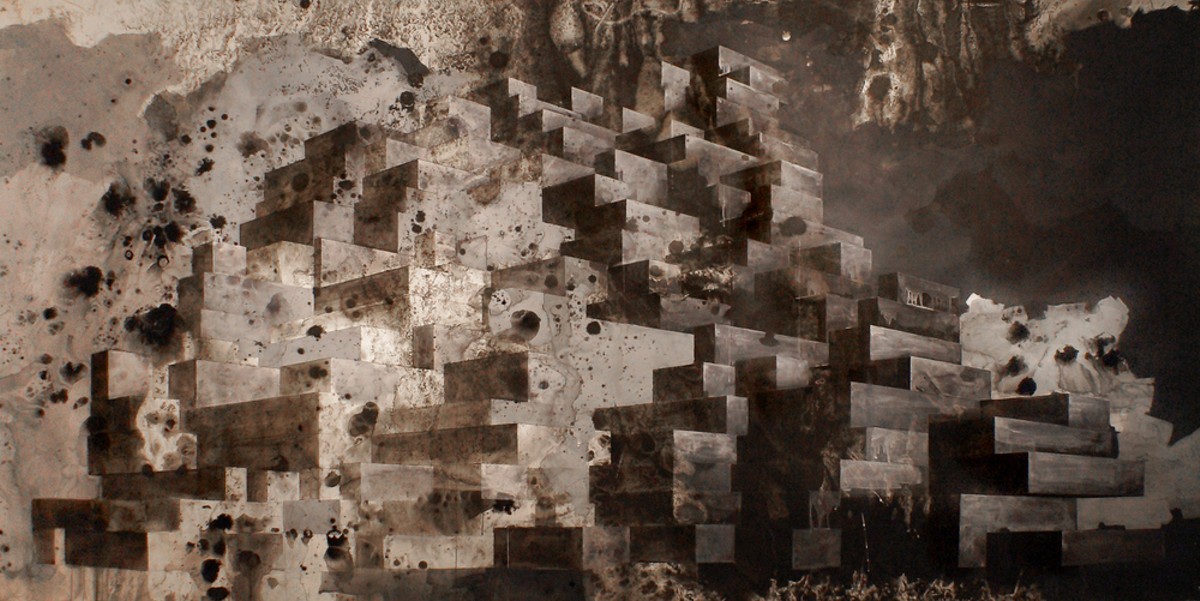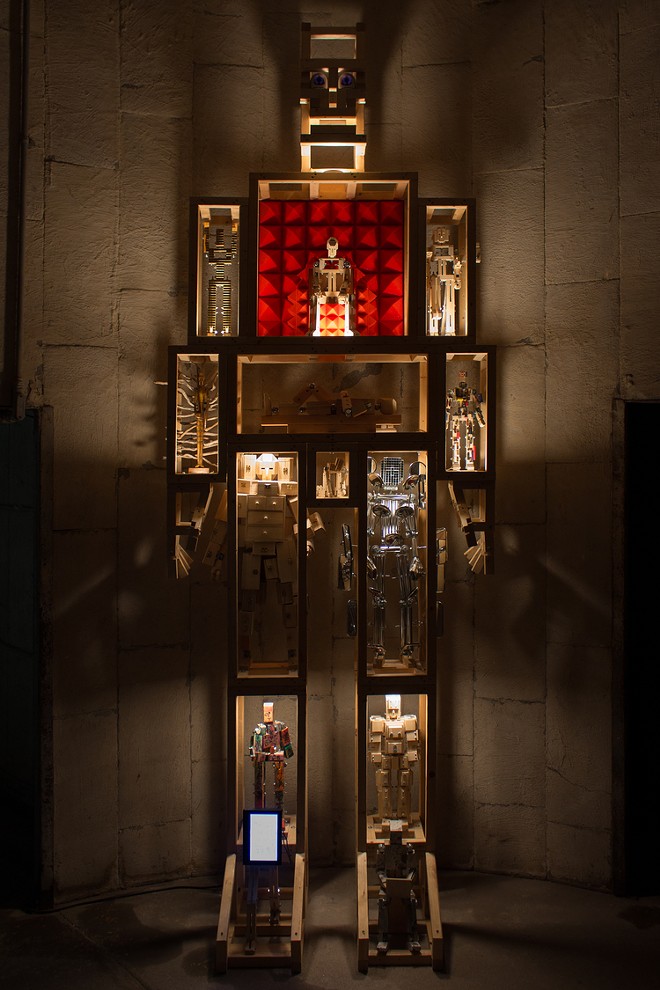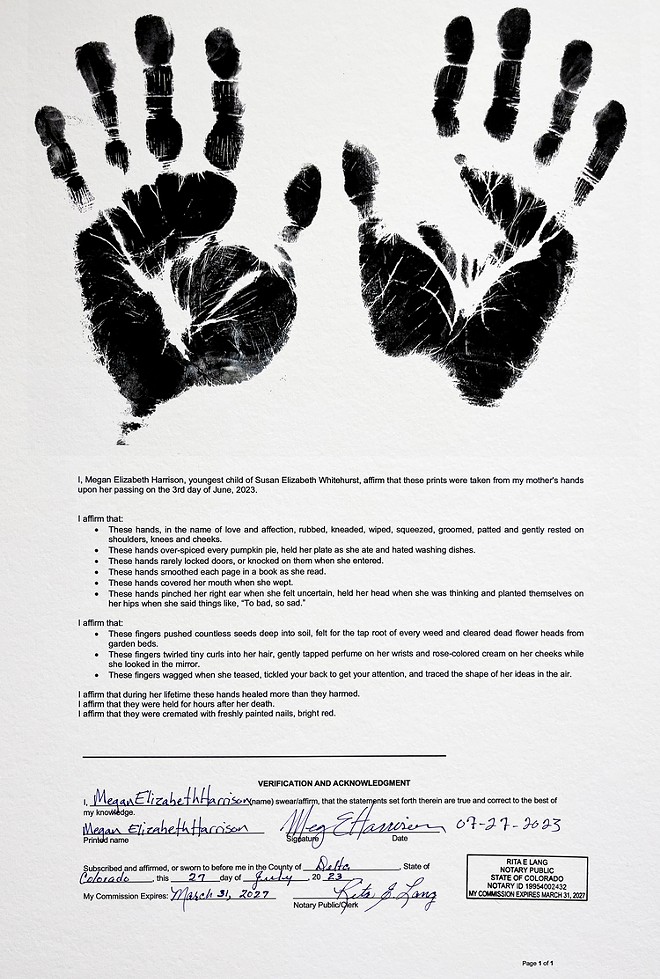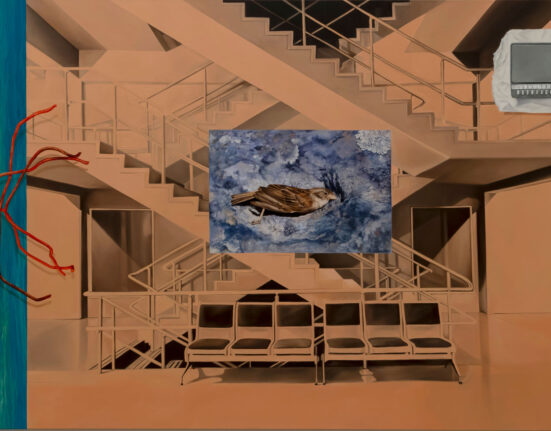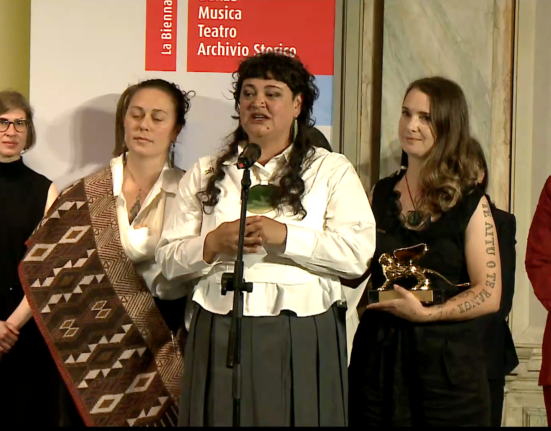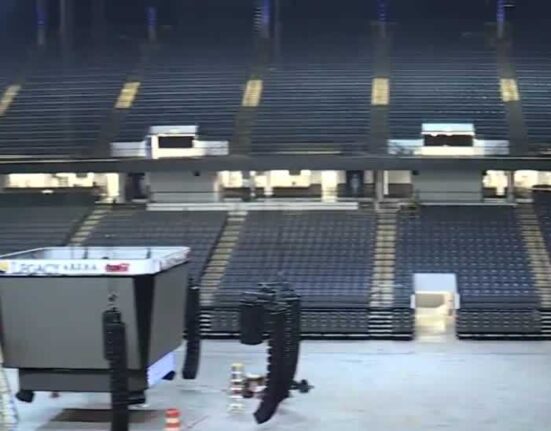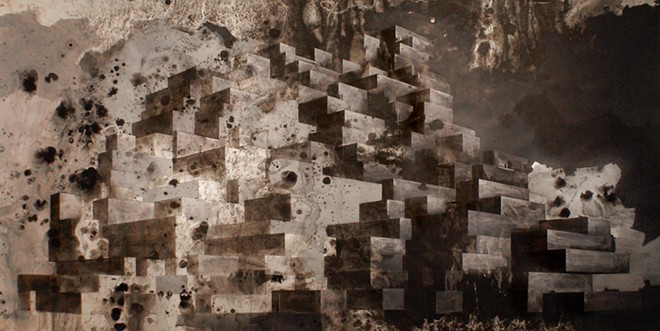
Courtesy Image / Megan Harrison
Megan Harrison’s Atramentite is emblematic of her her earlier work, which includes exploration of form and considerations of positive and negative space.
If one were to look at the creations of San Antonio artists Megan Harrison and Jimmy James Canales as two separate trajectories, it would be nearly impossible to guess they’re a couple.
Their practices seem that disparate. Currently working out of their modest home just north of downtown, the couple slips with ease between artmaking, parenting and day jobs. There have been moments over the years in which their individual practices intersect, parallel and complement one another — and right now is definitely one of those moments.
Much of Harrison’s early work is austere and formal, including explorations of form and considerations of positive and negative space. After finishing her studies, her focus shifted to address the tangible push and pull of micro versus macro ways of organizing the world. To do so, she reproduced processes found in nature, including the replication of crystalline structures and the oscillation of fluids in pursuit of a sort of esoteric mimicry.
There’s an alchemy in the way she uses simple materials such as ink and water to create abstract forms that self-organize, resembling galactic events frozen in time. The work simulates scientific processes, yet the results feel philosophical.
“I feel like a scientist in the way that a child is a kind of scientist,” Harrison says, “engaging with the physical world through curiosity, trial and error and mess-making. What comes from this process can be very vague until a set of possibilities that interests me starts to emerge. A chord gets struck, a glimpse of a specific emotion or rhyme with some tangled knot of experience — and then I dig there.”
Harrison is one of a pack of extraordinary artists who happened to attend the University of Texas at San Antonio from roughly 2010 through 2013. That group includes Casey and Tommy Gregory, Joe Harjo and Julie Ledet — also a couple — and Harrison’s partner, Canales.
Initially posturing himself as a performance artist with great success, Canales has staged hilarious scenarios that range from a mock duel in the parking lot of Parchman Stremmel Gallery, courting a potted cactus at a local icehouse and inviting his professors to spit wine onto his naked body at his final grad school critique. His performative works share a heightened sense of theatricality, impracticality and humor, often poking fun at the macho aspects of Latino culture.
Canales’ props grew increasingly complex over time, and his performances became increasingly rooted in durational concerns. Another shift — an overlapping one — reveals the limitations of human endurance. One series involved Canales circumnavigating the city multiple times and culminated with the artist walking all the way from San Antonio to Austin, as if setting out on a mock Corps of Discovery expedition to the Great White North.
Charted and tamed
Here is one point in which Canales and Harrison’s practices intersect. In 2015, the duo embarked on a cross-country road trip entitled Re-charting Pre-charted Territory, an exploration of the challenges of making work outside the safety of the studio.
It was an intentionally futile endeavor since the American landscape has already been charted and tamed, and the handful of places that remain wild, such as parks and nature preserves, are highly regulated. That said, the journey wasn’t fruitless. The duo returned to San Antonio some seven and a half months later with thousands of photos, drawings, paintings and objects in tow — enough raw material to keep them both busy for decades.
“I remember the point where I let go of trying to know at the outset what I was doing, what my art was supposed to mean or what it would look like,” Harrison says. “I look back on the stories of the Arctic explorers with a much more critical eye now — like, WTF were they doing out there? — and how their ambitions reveal profound privilege, access and hubris. But I am still inspired by moments of unbelievable endurance and the act of giving oneself over to the unknown — to the adventure — and doing the thing that scares you the most.”
Upon the couple’s return, each turned their attention back to their individual studio practices.
Harrison began mining images collected on their journey, creating fanciful landscapes that are alternately real, imagined and combinations thereof. Canales moved away from performance and began to create absurdist objects that enhance the body in some form or fashion. His objects are sculptural but not static, performative and, in some cases, transformative.
“They are proxies, avatars — puppets that stand in for me as the performer,” Canales says. “They satisfy my Geppetto complex, parts of my psyche, the anxiety surrounding obsolescence and outright narcissism. Explorations of the self are inherently narcissistic, but they are also universal and accessible.”
Increasingly autobiographical
Since 2020, the couple’s practices have intertwined in ways no one could have predicted, which began when their second child was stillborn. The lenses through which both artists filter the world shifted completely inward.
Harrison’s work became increasingly autobiographical, and Canales’ objects addressing the limitations of the human body took on new meaning and tragic significance. While still processing the loss, her mother Susan died suddenly and unexpectedly last summer. The couple happened to be in Colorado — Harrison’s home state, where she was doing a residency — and the pair was able to get to the hospital quickly.
In our culture, death is sanitized, ostensibly removed from the realm of “the natural.” When someone passes, it is assumed their remains will be removed immediately, emotionally distancing family and friends from the event. Harrison didn’t allow this to happen. She stayed with her mother for hours, had her IVs and tubes removed, bathed her and dressed her.
“For me it was a process of caring,” the artist says, “and caring for my mother during that time was a sacred act. I am using the word sacred because all words fall short. Maybe sublime works: an experience of total awe, love, joy, but also total disbelief, terror and grief.”
Her recent exhibition The Visit at Palo Alto College reflects on this experience and the void left by her mother.
‘Less scary to me’
The most unusual act Harrison performed while in the hospital was to ink her mother’s hands and press them onto a piece of paper. From this, she created a print which is the centerpiece of The Visit. It sits on her mother’s desk as a notarized testament to how we position ourselves between the past and the present and how we honor the importance and memory of individual histories even as they unravel.
“I think in my current work there are a lot of actions with the hands that mimic caring: washing, patting, smoothing, lifting, wrapping, holding … . These actions are physical, intuitive, repetitive, meditative, a nod to the sacred, a way to catch the echo of a sublime experience and a way to exercise my need to keep caring for this woman,” she says. “The exhibition feels like her apartment in her absence — still, dim, unchanging. It is strange that the container of her life is suddenly defined. The end is now set just as firmly as the beginning, and everything that took place within that container is now known.”
The death continues to have a profound effect.
“The thought of her not being here still knocks me over,” says Harrison. “How could this woman who built an entire universe for me disappear? She was a very present person, curious, complicated, unafraid of leaping. Death does seem less scary to me now because she has made that journey. If she can do it, I can do it too. We will share that experience someday.”
She continues: “I think about all of the things I inherited. Slowly, my mother has become the kitchen towel that I dry my hands on, the cup that I drink my coffee from and the sweater I wear when the morning is cool.”
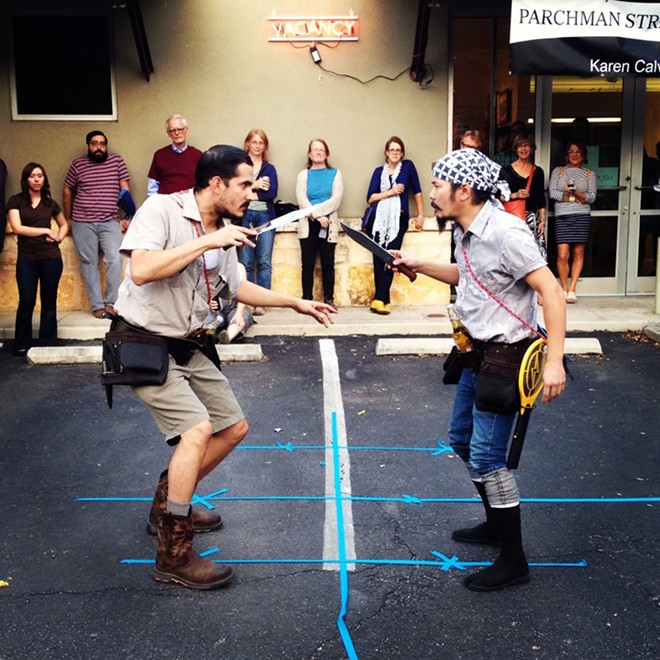
Joe Harjo
Jimmy James Canales’ performance pieces include Duel, a mock battle outside the Parchman Stremmel Gallery.
Side by side
In Canales’ most recent exhibition, ZUZSAN, at SITE Gallery in Houston, the central piece is dedicated to his mother-in-law. It’s a larger-than-life Transformer with smaller robots inhabiting the limbs, torso and head.
The artist describes this work as a “monument to the mythology of fragments,” likening it to a golem or Medieval Zodiac Man. In early Western medicine, Zodiac Man formed the basis of how doctors scheduled surgical practices — each limb is ruled by a specific astrological sign — and is related to the four humors then thought to govern the body’s functions. The work also resembles reliquaries, ofrendas to the dead or descansos (roadside shrines). For Canales, the whole remains open-ended.
Both artists are clearly still working through their grief side by side. There is no timeline for such a process.
“As a couple, I think we learned to leap together, and that has been a great theme in our relationship,” Harrison says. “There is a habit of trusting the adventure as impractical as they often seem. As far as collaboration goes, it is not a straightforward process for us. We think very differently as artists and have trouble deciding on a single direction or how to get there, but we do influence each other’s work profoundly. Mostly by bringing thoughts, images, concepts, artists, etc., into each other’s orbit, we expand our universe of ideas and possibilities. Someday we might realize that we’ve been collaborating all along. We just started on opposite ends.”
Subscribe to SA Current newsletters.
Follow us: Apple News | Google News | NewsBreak | Reddit | Instagram | Facebook | Twitter| Or sign up for our RSS Feed

